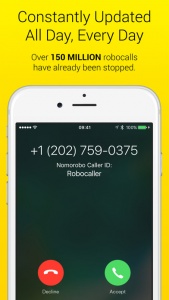I think we can all agree that everyone hates robocalls that inundate our phones lines all day. I do, and I’m a marketer. It’s feels like a total invasion of our privacy. And they seem to always call at dinner time – right? Have you noticed an increase in those annoying robocalls, telemarketers, and scams hitting up your smartphone all hours of the day and night? I have, and it’s driving me crazy. Part of the reason is that the “Do not call” registry doesn’t work 100% of the time, but I will still recommend you sign up. They cant keep up with the technology and keep up with devious companies.
So how can we stop these robocalls? Can we? They seem impossible to stop, but there are steps you can take, apps you can download, and places you can send complaints too.

What is a robocall?
A robocall is a phone call that uses a computerized autodialer to deliver a pre-recorded message, as if from a robot. Robocalls are often associated with political and telemarketing phone campaigns, but can also be used for public-service or emergency announcements.
According to the Federal Communications Commission, there are nearly 2.4 billion robocalls made every month. That’s more than 7 calls per person
-Research from the YouMail Robocall Index.
BEWARE: New types of robocall scams:
Your cell phone rings, and the number that flashes across the screen has the same area code and prefix as yours. So you may pick up, and sure enough – it’s a telemarketer again. It’s one of the newer scams to entice you to pick up.
 What can you do to ward off these annoying calls?
What can you do to ward off these annoying calls?
1. Google your smartphone number
Let’s start with a little reality. How are Robo-callers getting your phone numbers in the first place? Unfortunately, we’re all guilty of giving out our numbers when we register online at shopping sites, social media or any number of websites. The Better Business Bureau recommends Googling your own number. So go ahead and look – right now!
Was it there? Yup. So was mine. It might not be alongside your name, or other related personal information, but it is just one step closer a criminal has to put your information together.
Now that you know your out there at least you can deal with it.
2. Add your number to the Do No Call list
You can add your home phone and cell here National Do Not Call list.
If you’re already on the Do Not Call Registry and still get calls, then report the calls to the FTC, which processes the reports and hands out the fines.
Smartphone Tips:
On iPhones, tap the green phone icon on your home screen, select the “Recents” tab on the bottom of the screen, then tap the blue “i” information icon next to the phone number you want to block. A screen pops up with a bunch of options and at the very bottom you’ll find “Block This Caller.” Tap it and then when the verification screen appears, confirm your decision.
On most Androids, there are two easy ways to block numbers. If you’re on the standard version of Android 6.0 you can go into your call log and long-press on the number you want to block, then select “Block number” from the pop-up menu.
You can also select “Settings” and then “Call blocking,” then tap “Add number” and type in the number you want to block.
3. Hang up right away
“There is nothing to gain from attempting to reason with the people behind the calls,” said the BBB. With that said I have heard that you should pick up and wait for the Robot to start speaking and then hang up. At least then you get recored as being reached and maybe you’ll be taken off the list.
4. Don’t press numbers
In the past, many people have recommended certain number combinations or the pound key to delete yourself from a robocall registry, but the BBB you’re actually making it worse: “By pressing a number, you are confirming that someone is actually responding to the call, and you will likely receive more of them.”
 5. Other options
5. Other options
There are a couple apps that promise anti-spam deterrents that will stop annoying calls for good. They all require a bit of set-up, but they do work. You have to update the app with your numbers os there is work on your side.
Nomorobo – (iOS) – One of the best of these apps is Nomorobo. They won a competition by the FTC. After you download the app onto your device, you can sign up for a free trial for 30-days, or commit right away to either $1.99 per month or $19.99 per year.
Truecaller – This paid app (iPhone, Android, Windows Phone) reports that it’s collected more than 3-billion phone numbers and relies on information from users to filter out the scams. When the app identifies a specific phone number as robocall or scam, it lets you know with an alert on the call screen. The website says it gets its information from a central database that is constantly being updated with new phone numbers.
 What is the government doing?
What is the government doing?
The Federal Communications Commission proposed allowing phone companies, both landline and wireless, to block spoofed robocalls when the number cannot possibly be valid. That would include unassigned numbers and those from area codes that don’t exist.
What are your rights?
“The federal Telemarketing Sales Rule prohibits recorded sales messages unless you have given written permission for the caller to contact you, regardless of whether or not your number is on the Do Not Call registry (www.donotcall.gov),” the BBB says. “The Federal Trade Commission(FTC) has used its enforcement authority to stop companies that have made billions of auto-dialed calls, but acknowledges that technology has helped significantly increase these calls in recent years. This technology helps criminals generate calls from anywhere in the world and falsify caller ID technology to cover their steps.”
It’s also important to note that unsolicited, non-emergency robocalls to wireless phones are illegal, end of story!